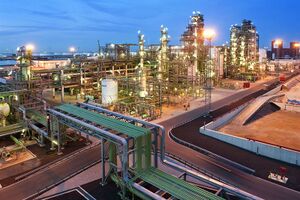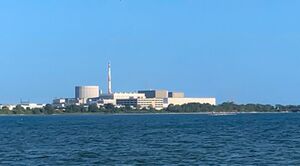Energy production in Arvor: Difference between revisions
m (→Biodiesel) |
mNo edit summary |
||
| Line 3: | Line 3: | ||
==Biodiesel== | ==Biodiesel== | ||
[[File:Biodizavod.jpg|thumb | [[File:Biodizavod.jpg|thumb|Biodiesel production facility.]] | ||
Biodiesel is the primary stored fuel source in the ADR. It is produced from vegetable oils, yellow grease, used cooking oils, and animal fats. These are collected from food production firms, restaurants, and farms. The fuel is produced by transesterification — a process that converts fats and oils into biodiesel and glycerin (a coproduct). Approximately 45.359 kilograms (100 pounds) of oil or fat are reacted with 4.535 kilograms (10 pounds) of a short-chain alcohol (usually methanol) in the presence of a catalyst (usually sodium hydroxide [NaOH] or potassium hydroxide [KOH]) to form 45.359 kilograms of biodiesel and 4.535 kilograms of glycerin (or glycerol). Glycerin, the coproduct produced in the same process, is a sugar commonly used in the manufacture of pharmaceuticals and cosmetics. A dry wash process is used in removing contaminants from the fuel and serves to reduce water consumption. | Biodiesel is the primary stored fuel source in the ADR. It is produced from vegetable oils, yellow grease, used cooking oils, and animal fats. These are collected from food production firms, restaurants, and farms. The fuel is produced by transesterification — a process that converts fats and oils into biodiesel and glycerin (a coproduct). Approximately 45.359 kilograms (100 pounds) of oil or fat are reacted with 4.535 kilograms (10 pounds) of a short-chain alcohol (usually methanol) in the presence of a catalyst (usually sodium hydroxide [NaOH] or potassium hydroxide [KOH]) to form 45.359 kilograms of biodiesel and 4.535 kilograms of glycerin (or glycerol). Glycerin, the coproduct produced in the same process, is a sugar commonly used in the manufacture of pharmaceuticals and cosmetics. A dry wash process is used in removing contaminants from the fuel and serves to reduce water consumption. | ||
Revision as of 23:36, 16 June 2024
Energy production in Arvor comes from four primary sources: biodiesel, nuclear, hydropower, and solar.
Biodiesel

Biodiesel is the primary stored fuel source in the ADR. It is produced from vegetable oils, yellow grease, used cooking oils, and animal fats. These are collected from food production firms, restaurants, and farms. The fuel is produced by transesterification — a process that converts fats and oils into biodiesel and glycerin (a coproduct). Approximately 45.359 kilograms (100 pounds) of oil or fat are reacted with 4.535 kilograms (10 pounds) of a short-chain alcohol (usually methanol) in the presence of a catalyst (usually sodium hydroxide [NaOH] or potassium hydroxide [KOH]) to form 45.359 kilograms of biodiesel and 4.535 kilograms of glycerin (or glycerol). Glycerin, the coproduct produced in the same process, is a sugar commonly used in the manufacture of pharmaceuticals and cosmetics. A dry wash process is used in removing contaminants from the fuel and serves to reduce water consumption.
Biodiesel is distributed from the point of production to terminals and wholesalers by truck or train. B5 is sometimes shipped by pipeline. Most biodiesel distributors will deliver B20 or B100 depending on the retailer's preference.
As of 1.1.7689 RH, GP Biodizprom is the world's largest producer of biodiesel worldwide. As of the same year, a litre of biodiesel costs ₽3. A typical automobile can go 19.11 kilometres (11.88 miles) per litre of fuel.
Nuclear

Thanks to sizable vesium resources, Arvor has a robust nuclear power industry, and is a world leader in the technology. Initially spurred on by the development of nuclear weapons, further studies conducted by the Zeldovich Research Bureau of TsIIR demonstrated the feasibility of civilian nuclear power, which led to the construction of the world's first atomic power station, Ryarmansk Generating Station, in 7673 RH. It has since be decommissioned and replaced by a newer, more modern facility.
Approximately 68% of all electricity generated by Gosvlast is produced via nuclear reactors. A regular programme of fuel replacement is maintained, and fuel assemblies removed from reactors are sent for recycling, which allows them to be reused in reactors in the future. In this way, the volume of highly radioactive waste is reduced by 5 and the long-term radiotoxicity by 10.
Hydro
TBD